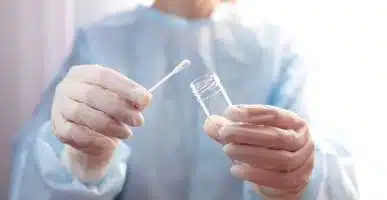
Cervical exam
Susan, Ureaplasma Test visit 2, day 8
Assessment:
- “Probable GC/CT/PID”
- Possible allergy
- Consider gonorrhoea, tenosynovitis
Plan:
- Ceftriaxone 250mg IM plus 750mg IV
- Doxycycline 100mg PO BID X 10 days
- HIV, VDRL, GC, CT tests, plus CBC, chem panel
Return tomorrow
Susan, visit 3, day 9
- Symptoms slightly improved (rash, leg and foot pain, dysuria).
- Repeated ceftriaxone 1g IV per plan
- Urine culture from the first visit: mixed flora x103
- CT/GC from yesterday was negative
Assessment: “Picture, w/ triad of urethane, rash and foot pain.”
- ECG, blood cultures, repeat UA, chem panel, and cryoglobulins done today
Susan, visit 4, day 10
- Symptoms persist, pt
- Pelvic exam repeated, same findings
- Labs: GC/CT repeated, HSV PCR (urethral swab), HSV serology done
- Derm biopsy done; consider EM, vasculitis
Therefore, despite spending more than $1000 trying to figure out Ureaplasma,
What’s going on?
Susan
- HSV PCR positive for HSV-2, and
- HSV also positive for HSV-2
- Derm biopsy result shows a syndrome and
- The was started, and symptoms resolved within one week
- Retrospective history: The partner had a history of penile lesions one month earlier.
Papular
Genital Herpes – teaching points:
- Dysuria, with or without genital lesions, is a common symptom of genital herpes and
- Herpes should be considered early UTI symptoms.
- Herpes can also cause florid cervicitis, as occurred in this patient.
- HSV PCR tests are highly sensitive and specific
- Test of choice for lesion or symptom
Mark
CC: night sweats, body aches, blood in urine
HPI: 21 y.o. Male w/ night sweats X 1 week but no fever. The Dysuria began 3 days ago with intense pain and some urgency. Furthermore, urethral discharge X 1 day and bright red hematuria were noted yesterday. However, the patient reports having had 2 female sexual partners recently. And specifically, this includes someone he “barely knows” but used condoms 100% with these partners.
Mark, continued
- Additional Ureaplasma history:
I was backpacking in Central America one month ago with friends and developed profuse, watery diarrhoea one week after returning. The diarrhoea resolved shortly before the urinary symptoms started.
- Exam:
Temp 97.4F, VS normal,
- Assessment:
Urethritis, hematuria, night sweats
Mark, continued
Plan:
- Azithromycin 1g PO single dose
- Urine CT/GC
- Urinalysis and urine culture
- UA result: + LE, + Heme, + protein, WBC clumps, full field
- RBC, no bacteria
- CBC and panel
But is this a case of urethritis?
Therefore, why or why not?
Mark, continued
- Returns to the clinic the next day, reporting that his dysuria is worse and he has penile pain at rest
- PE repeated, findings unchanged.
- Further history provides some more details:
- The last unprotected sex was 4 mo ago.
- Diarrheal illness was followed by sweats/ chills,
- Arthralgias, fatigue, myalgias, then urinary sex.
- Due to concerns about possible prostatitis, he was started on a course of ciprofloxacin 500mg
Mark, continued
Final lab results:
- Chlamydia & gonorrhea: negative
- CBC/chem panel: normal
- Urine culture: positive isolate for Salmonella Havana
Resolution
- Symptoms resolved quickly after starting Cipro
- Dx: Salmonella Urethritis? Cystitis? Prostatitis?
Mark – discussion
- Urethritis can have multiple
- Only 50% are chlamydia or gonorrhea
- Other causes include HSV, trich, adenovirus, mycoplasma
- Nearly always sexually acquired in young men …but probably not in this case
- Salmonella as a cause of UTI is reported infrequently, usually with preceding gastroenteritis
- The source could be hematogenous or directly spread secondary to illness
Brittany
So Brittany is a 19-year-old female who presented to the Women’s Health Clinic for “STI testing.”
However, she was seen for an annual physical exam at her home clinic over the summer. At that time, she tested positive on a cervical culture for Ureaplasma urealyticum. However, she was treated with a two-week course of erythromycin and advised to undergo a test for a cure in two months.
Brittany continued
- Testing for U. urealyticum is not performed at the SHS, and the evidence does not support routine checks or treatment. However, we had little to offer this patient.
- Therefore, the provider contacted the provider back home. However, the doctor stated that her environment and practice patterns were required to treat Ureaplasma.
What are Myco?
- Smallest known free-living life forms.
- Prokaryotes, but lack a cell wall.
- The cell membrane contains sterols.
- Extracellular parasites attach to the surface of epithelial cells of the respiratory and genital tracts.
Genital Myco
Furthermore, several species of mycoplasma are known to colonize the genital tract:
- Mycoplasma hominis
- Ureaplasma urealyticum
- Myco premium
- Myco genitalium
- Myco spermatophilum
- Myco penetrants
Therefore, M. hominis, M. genitalium and U. urealyticum are potential urogenital pathogens attributed to causing nongonococcal urethritis, cervicitis, and pelvic inflammatory disease.
Epidemiology
- M. hominis and U. urealyticum colonize the genital and urinary tracts of postpubertal females and males. Ureaplasma colonizes as many as 40-80% of asymptomatic, sexually active patients.
- Female colonization is maximal in the vagina and less in the endocervix, urethra, or endometrium.
- Male colonization occurs primarily in the urethra.
- Colonization rates are directly related to sexual activity and are highest among persons with multiple sexual partners.
- Research has not shown a definitive association between M. hominis or U. urealyticum and symptomatic infections in women; some have suggested a relationship between PID and infertility.
